My son Philip moved to Karratha, northwest Western Australia, to take up a job with the Department of Water early this year. While still on hiatus, and it being cold as all get out down south, plus a free return flight to anywhere in Australia courtesy of Qantas (their way of saying sorry for the ‘inconvenience’ of grounding the Qantas fleet last year), it seemed as good a time as any to pay Philip a visit.
Some general notes on habitat and conditions
The Pilbara is largely untouched apart from mining operations, which tend to be localised and don’t seem to be having a great impact on the natural environment as a whole. The mining companies’ physical infrastructure (roads, rail and powerlines) is the more obvious clue to their presence.
The major vegetation of the region is triodia hummock grass (referred to as spinifex in this report), which is lightly grazed by cattle in the lower areas and not at all in the hills.
The Pilbara would seem an important wintering area for a great many inland nomadic and migratory bird species. It would be interesting to know how many of those nomadic birds breed in this area. Presumably the numbers of wintering birds varies from year to year depending on rainfall and prevailing conditions in other parts of Australia. The wet season prior to my visit wasn’t a particularly good one but still there were a lot of birds around in places. The mulga country and the larger river systems had the richest birdlife and as to be expected, the spinifex ridges and gorges the least. The Pilbara didn’t escape the drought that afflicted much of Australia for most of the first decade of this millennium, and many rivers in the Pilbara didn’t flow for several years. As elsewhere in Australia, it will take some time for resident species, such as striated grasswren (endemic subsp.) and rufous-crowned emu-wren to recover their numbers. Given I only located one grasswren they appear to very scarce and/or sparsely distributed, or very quiet in June.
As to the emu-wren (what emu-wren!) there’s lots of spinifex country but I suspect that much of it is too thick or it's burnt too frequently. (Rufous-crowned emu-wren is quite common south of Cloncurry in the Gulf of Carpentaria [Queensland] where they inhabit large clumps of sparse spinifex, which would rarely if ever burn, as there’s much stony ground between the clumps. Most of the spinifex clumps in the Pilbara were touching and had massive seed heads above the clumps, rendering this habitat very fire prone.
The black-throated treecreeper (endemic subsp.) also appeared to be scarce. The other two endemic subspecies, the blue-winged kookaburra and spinifex pigeon appear to be reasonably common in suitable habitat.
Many of the mulga birds such as Bourke’s parrot, chestnut-rumped, inland and slaty-backed thornbills, western gerygone and grey honeyeater are at the northwest limits of their range, southeast of Karratha. Mulga is also at the limits of its distribution in this area.
The similarity of the Pilbara and the aforementioned Gulf Country of Queensland is striking, particularly around Mt Isa and Cloncurry. Miles of spinifex-covered ridges, sparsely vegetated with snappy gums and flatter areas of spinifex are common to both areas. The rocky outcrops of the Chichester and Hamersley ranges are reminiscent of the Selwyn Range south of Cloncurry; the Pilbara ranges being a little more rugged and spectacular than the Gulf ranges. The birdlife is not dissimilar, with grey-headed honeyeater, spinifex pigeon and painted finch abundant in both areas.
4 June 2012
Burrup Peninsula
Currently there are direct flights from Melbourne to Karratha on a Monday; I caught one of these and landed mid-afternoon to a balmy 27°C. Philip and I headed out for a drive around the peninsula. The better bird sightings were pallid cuckoo, little woodswallow, Horsfield’s bronze-cuckoo, Brahminy kite, western bowerbird, yellow white-eye, black-shouldered kite, and a great number of red-backed kingfishers.
5 June Tuesday
Roebourne — Wittenoon Road and Millstream Chichester NP.
I gathered a bit of camping gear together and bought supplies. All this country was new to me so the plan was to spend a couple of days camping in the Millstream Chichester NP. I headed down the Roebourne — Witternoon Road, a relatively quiet back road into Millstream — Chichester NP that Philip thought good for birds. Travelling not too far down that road I came to a large waterhole where finches were coming in to drink. They were mostly zebra finches with a sprinkling of pictorella mannikins, which were nearly all juveniles. A few painted finches were coming in to a nearby waterhole; as were small flocks of budgies and many diamond doves. Several rainbow bee-eaters were hawking insects over the water.
Another ten kilometres or so down the road I pulled up at a creekline. First birds seen were a group of the rufous-breasted race of grey-crown babbler Pomatostomus temporalis rubeculus. Rufous songlark and white-winged trillers, presumably overwintering, were added to the list. Many white-plumed honeyeaters were seen. These white-plumeds were quite different to what I’m familiar with, having a very yellow head, primaries and tail with a contrasting grey breast and a black line in front of the white crescent. There are quite a few races of variegated fairywrens throughout Australia. The male variegated fairywren seen in the undergrowth here was also somewhat different to what I’m familiar with in the Riverina, although it would seem to be of the same race, Malurus lamberti assimilis. From my brief view, the male had a very white breast, contrasting with a very black bib. Also the pale blue coming down behind the eye seemed quite narrow. A better look was needed. More little woodswallows were seen along the ridges.
9 & 10 June Wittenoon Gorge
On the weekend we headed out towards Karijini NP, about three hundred kilometres southeast of Karratha. I had some old information about sites for striated grasswren and rufous-crowned emu-wren and here was my opportunity to check them out. Wittenoon is infamous for its blue asbestos mine. Not too many people go there nowadays. With all signage removed, it’s like it never existed. We could not locate the first track to Bee Gorge, west of Wittenoon, so continued on to Wittenoon Gorge south of the old town. The gorge itself is a beautiful spot with permanent waterholes scattered all the way along. We pulled up near the locality I had been given some twenty or so years ago. There were miles of spinifex-covered ridges, which looked like they hadn’t seen fire for a long time. The main gorge was lined with a scattering of river redgums and other trees and shrubs. Lots of flowering holy-leaf grevillea was growing up the side gorges. We were lunching up one of these side gorges when a dozen or so pied honeyeaters flew into the grevilleas. Pied honeyeater is a highly nomadic species and this group looked like they were in travel mode. Birds weren’t particularly plentiful but we did have lots of painted finches, mostly in pairs, and brown and grey-headed honeyeaters and weebill around the lunch spot. The weebill here is not as yellow as in the Topend but slightly yellower than ours in the southeast, particularly about the vent. The first striated pardalotes were seen; the red-browed being more common elsewhere in the Pilbara. Zebra finches and diamond doves were in good numbers and we saw a few flocks of budgies.
This was the habitat for the Pilbara striated grasswren Amytornis striatus whitei. It was unlike the habitat of the other races, except for the spinifex. The only grasswren habitat that looks a little like it is that of the recently split short-tailed grasswren in the Flinders and Gawler ranges of South Australia, a very long way from the Pilbara. In proximity, the closest race is Amytornis striatus striatus in its rufous form inhabiting the red sandy spinifex country in central Australia. The habitat was rugged. I set off up the ridge, doing my best to stay upright on challenging terrain, and had not gone far when a hesitant spinifexbird came out, allowing a decent if brief look. There was an old bull-dosed track, high up on the ridge running parallel to the gorge that made walking easier. I continued along this track for a few kilometres seeing very little and wondering if striated grasswrens were still here at all. The decade long drought we had in southern Australia had greatly diminished striated grasswren numbers. The Pilbara too had been hit by severe drought at times and I wondered if populations up here had been decimated as well. Musing on this possibility I climbed one more ridge and was at the point of turning back when I heard a grasswren-like call. Certainly different from the striated grasswrens calls I know. I coaxed the bird out with a squeaker. A female (I think), it was nowhere near as cinnamon-rufous on the back as the sandy desert race. The back, tail and eyebrow were more of a deep chestnut, and underparts a paler chestnut. She had a greyish breast contrasting with a white throat. The colours merged with the Pilbara rock. The mate may have been on the nest as striated grasswrens are usually in pairs when not nesting. To my mind all the striated grasswren races could be separate species. They are each distinctive, at least as distinctive as the short-tailed grasswren; all have been isolated from each others for eons, and each lives in slightly different habitat, the common factor being spinifex.
Needing to set up camp, Philip and I moved up the gorge. Other than the twilight chortle of the Pilbara race of blue-winged kookaburra Dacelo leachii occidentalis, silence reigned ‘til morning.
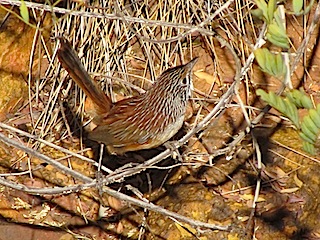 |
|
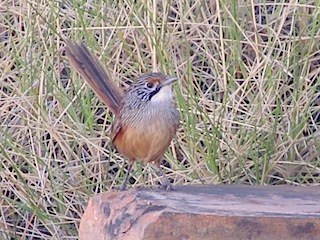 |
| Pilbara race of striated grasswren (female?) |
Up early, we headed back up the ridge to the grasswren spot with the hope of recording the call. Yesterday’s bird was proving uncooperative, the only call heard this morning being a distant one. It completely ignored the tape of the mallee form of striated grasswren, fuelling my theory that this race could be/should be a separate species. Another bird was heard further along in thick spinifex and low acacia; it too didn’t respond to the squeaker or tape and remained unseen. I don’t know whether this species has been drought affected, but one thing is for sure, at this locality striated grasswrens are few and far between.
Other interesting sightings included painted finches, all in pairs; some were nest building, i.e., seen carrying charcoal or some other substance into partially constructed nests. A few pairs of little woodswallows were observed as was black-faced cuckoo-shrike, rufous whistler and white-winged triller. Back at camp we had Torresian crow, peaceful dove and a pair of collared sparrowhawk. A couple of blue-winged kookaburras were seen along the gorge. The most noticeable difference from the widespread nominate race is that the head is less hoary and the breast more buff and lacking in barring in this Pilbara race.
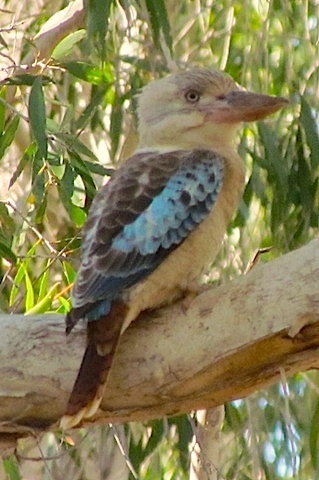 |
| Pilbara race of the blue-winged kookaburra |
Approaching Millstream on our way home, we saw a mass of masked woodswallows and budgies, as well as several spotted harriers. Towards Karratha, heavy unseasonal rain bucketed down.
Cleaverville mangroves & De Grey River 12 & 13 June Tuesday & Wednesday
Cleaverville is a popular camping area for those that fish. It's found by travelling about twenty kilometres east of Karratha and then about ten kilometres north to the coast. It turned out to be an excellent area for mangrove birds and despite the sticky black mud I saw dusky gerygone, about ten white-breasted whistlers, mangrove grey fantail, mangrove robin, yellow white-eye and a single mangrove golden whistler. Other species of interest included three ospreys, one of which had just caught a small stingray that it carried off, and I later saw eating; Bramhiny kite, little egret, rainbow bee-eater, sooty oystercatcher and star finch. Three cute spinifex pigeons were sitting on a rock by the road and then toddled down to a pool to drink. Obviously not a saltwater pool as I thought.
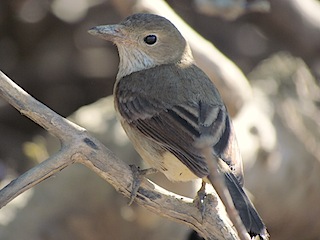 |
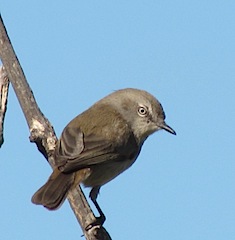 |
| white-breasted whistler, female |
Dusky gerygone |
Back on the highway I stopped at an area of open plains vegetated in part with a chenopod species. There was a large number of singing bushlarks of the dark rufous form and many brown songlarks. Both species were silent. All the brown songlarks were in non-breeding plumage. I checked out the white-winged fairywrens, of which there were several groups, to compare with ours down south. Of the coloured males, the head appeared to be a paler blue. Most birds however were in eclipse. My first black swans up here were seen on the Turner River. Several raptors were seen while I was travelling the North West Coast Highway to Port Hedland including three spotted harriers, about fifty whistling kite, two black kites and some brown falcons and kestrels. (From my travels in the Pilbara to date, whistling kites far outnumbered black kites; spotted harriers were common, wedgetail eagles rather scarce; and brown falcon much less common than kestrel, which itself is not abundant).
I continued on for another eighty or so kilometres east of Port Hedland to the De Grey River, where I was hoping to meet up with the Pilbara race of the black-tailed treecreeper. At dusk, on the southwest side of the river, a boobook owl flushed up off the track. Later, tucked up in my swag, I could hear the calls of a barking owl and bush stone curlew.
There was a feeding frenzy happening on the flowering Crotalaria cunninghamii (regal birdflower) the next morning. They are called birdflower because of the stylised birdlike shape of their green flowers but here they were swathed in real birds. White-plumed honeyeaters, yellow-throated miners and Australian ringnecks (western form) were feasting on them. A pair of black-chinned honeyeaters (golden-backed form) flew in but was seen off by the white-plumes.
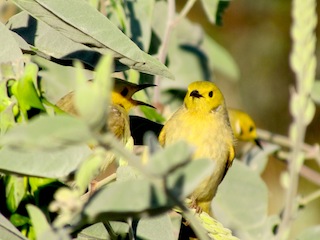 |
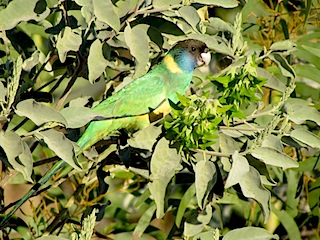 |
| White-plumed honeyeaters and Australian ringneck on Crotalaria cunninghamii |
There were some big flocks of star finch (mainly immatures) and zebra finches about. Down on the river I saw a yellow-billed spoonbill, lots of black-fronted dotterels and a few red-capped plover.
Walking downstream, a huge covey of brown quail exploded from under my feet. A western bowerbird flew over. Echidna tracks were evident. There was no sign of any treecreepers, perhaps due to a paucity of trees on this side of the river. I packed up and went over to the other side where a large drift of grey nomads was camped. It was shadier and the timber more extensive. In a redgum, a hobby plucked at a diamond dove.
hobby video http://youtu.be/ZzEnx3aZSto
The melaleucas and river redgums looked thicker upstream so I continued on searching for black-tailed treecreeper. An immature spotted harrier flew by and another light phase little eagle soared over the river. Red-browed pardalotes called.
A black-tailed treecreeper Climacteris melanurus wellsi was soon heard and a pair located. Compared to its northern counterpart, this Pilbara race is slightly smaller, more rufous on the breast and the pale buffy wing bar more prominent. An owlet nightjar called. Rufous songlark was seen and there were good flocks of star finches feeding by the river. All the birds were on edge, the white-plumed honeyeaters constantly giving alarm calls. The agitator was a large female brown goshawk moving stealthily through the trees. Blue-winged kookaburras only added to the honeyeaters’ disquiet.
 |
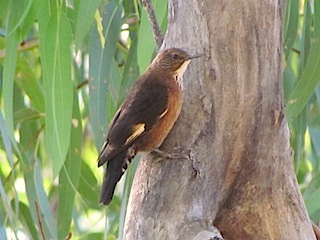 |
| Black-tailed treecreeper, male |
Black-tailed treecreeper, female |
Another black-tailed treecreeper called further downstream. This is not an over abundant species here. Other birds included white-winged triller, mistletoebird and fairy martin. The De Grey River is a great spot.
On the way back to Karratha I stopped in at Balla Balla opposite the Whim Creek Hotel. It’s another area of mangroves and mudflats, about twenty kilometres north of the highway. The track cuts through an extensive grassy plain. Down at the mangroves I saw mangrove golden and white-breasted whistlers, mangrove grey fantail, dusky gerygone, yellow white-eye and heard a mangrove robin. Recorded in nearby scrubby areas were crimson chat, white-winged triller, Horsfield’s bronze-cuckoo, black-faced woodswallow, black-shouldered kite, white-winged fairywren, diamond dove and little buttonquail. Gull-billed terns patrolled the plains and mudflats. A spotted harrier hunted over the grassy plains, and a wedge-tailed eagle, my first in the Pilbara, was sighted. Singing bushlark and brown songlark were about the plains, and back near the highway, a pallid cuckoo flew across. A good list for only a couple of hours' work.
14 June 2012 Thursday Dampier Archipelago
At this time of year it is often windy on the ocean but conditions looked good today so Philip and I took advantage of it. We again headed west from the Burrup Peninsula out around West Lewis, Enderby, Goodwyn and Rosemary Islands and as far west as Roly Rock. On the way out we encountered more Wilson’s storm-petrels, and had a few around us most of the day.
Philip let me out on West Lewis Island for an hour or so. The first bird seen on the island was an immature white-breasted sea-eagle and surprisingly the second was little corella. I didn’t know what to expect to see out there. We were only about ten kilometres offshore with islands dotted in between. The whole island is mainly a stony spinifex-covered hill with quite a lot of rock piles and rocky gullies with scrub and trees in them.
There was a flat area near the beach that had a patch of a soft spinifex species and I unsuccessfully searched there for white-winged fairywren . Species recorded were those recorded in similar habitat on the mainland, that is, pied butcherbird, white-winged triller, singing honeyeater and zebra finch. Brown songlark and pallid cuckoo surprised me a little. Great egret, a dark phase reef egret and white-faced heron were feeding in an inlet.
On the rock piles were dozens of small rock-wallabies, which I now knew to be Rothschild’s rock-wallaby, seen from the boat on our first fishing expedition. So quiet were they that I’d almost have to be on top of the younger ones before they’d emerge from the rubble and bound off to the next rock pile. They were similar to Alice Spring’s black-flanked rock-wallaby and Mt Isa’s purple-necked rock-wallaby. Some of these Rothschild’s also had the purplish-mauve neck of the Mt Isa rock-wallaby. The purplish-mauve colour is a short-lived pigmentation secreted by the skin of purple-necked rock-wallabies; and apparently also by Rothschild’s. (See photo).
On the mainland, it’s possible that Rothschild’s rock-wallaby has fallen prey to foxes as I didn’t see any in similar habitat although this species is supposedly in Karijini and on the Burrup Peninsula. I only covered a small section of the island but I must have seen at least fifty of these cute macropods. I came across an enormous aboriginal midden filled with huge shells, bones and grinding stones. The Ngarluma people, the traditional owners of coastal areas in these parts, would have come to the islands to feast on shellfish.
Philip returned to collect me and we continued fishing. He had caught a barracuda. He’d also seen something black in the water that may have been a dugong; he’d seen one in the area on a previous visit. We ventured way out near Roly Rock. Large flocks of roseate and crested terns were diving at bait fish.
A few cod, spangled emperor and coral trout were caught but most, being undersize, went back in the water. The fish started to retaliate and we almost had large angry sharks in the boat. Moving on seemed prudent. Trawling awhile, we caught a stripey mackerel.
On our way in a lesser frigatebird was seen near Malus Island. Not too many fish came home but it was an exciting day.
16 – 17 June 2012 Karijini NP
Philip and I headed out to Karijini NP, about 350 km SSE of Karratha.
Late in the morning we came upon a cattle trough teeming with zebra finches. The trough was about five kilometres east of the Tom Price Railway Road, on the Hamersley Road. No sooner had we pulled up to have a look when a hobby flashed through, nearly taking my head off. A collared sparrowhawk followed. There was a flock of little corellas and cockatiels, and there were a few flocks of budgies about.
In this area, south of the Fortescue River, we were starting to get into mulga country and were soon seeing red-capped and hooded robins.
Once in the park we took in some of the spectacular gorges, which were not overly birdy; spinifex pigeon probably being the best sighting.
There appeared to have been an extensive fire in the park some five or so years ago. Next morning Philip and I checked out some burnt mulga country on the south side of the highway and found two of our most nomadic species — black and white-fronted honeyeaters in a copse of flowering eremophila. Other species included singing and brown honeyeaters, magpie (not common up here), grey-crowned babbler, weebill, red-browed pardalote and a pair of hooded robins. Torresian crows and a brown falcon were harassing a docile wedge-tail eagle, perched in a tree. This wedgie was only the third I’d seen up here.
The vegetation in this burnt out area comprised many unfamiliar species. There were at least two species of bloodwood, one with almost perfectly circular seedpods. Also a bluish mallee tree with very long thin pods, as well as the eremophilas; the only one I knew being Eremophila longifolia. Some sort of exocarpus (a root parasite) was also noted.
Back in the park we looked around the Dales Gorge area hoping to encounter grasswren or emu-wren. Sadly no. Quite a few black-faced cuckoo-shrike were feasting on a fruiting fig down in the gorge but generally there wasn’t much about; striated pardalote, painted finch and collared sparrowhawk being among the few.
There were cypress pines in the gorge; the first I’d seen in the Pilbara. Other familiar plants included snappy gum, which is prevalent through the Gulf country of Queensland and western wonga vine, which also grows in western New South Wales.
After lunch we set off on the five-hour drive back to Karratha.
19 June 2012 Millstream Chichester NP and Karijini again
With less than a week to go, I headed back to Millstream Chichester NP and Karijini. I had seen all the Pilbara endemic subspecies but was determined to find the rufous-crowned emu-wren and hopefully more striated grasswrens.
My first stop was in the hills near the Harding River on the Tom Price Road, about seventy kilometres south of the highway. The spinifex ridges were quiet but near the river waterholes there were twenty or so painted finches, warily drinking. There were a couple of great egrets and my first white-necked heron around the waterholes, as well as ten white-faced herons, the biggest group I’d seen up here .
Dawson’s Creek on Snappy Gum Drive in Millstream Chichester NP was the next port of call. There was a league of masked woodswallows assembled in the redgums and a few small flocks of budgies buzzing about. A black-shouldered kite flushed from a tree. There were quite a few of black-shouldered kites around. I wondered what small mammal they were eating. House mouse might have been prey du jour as it had recently plagued over the inland.
The usual rufous songlarks, red-backed kingfishers, grey-crowned babblers and Australian ringnecks were seen. I thought I’d heard black-tailed treecreeper here but couldn’t locate it. There was enough timber along the creek to support them.
I had a couple of stops along the Fortescue River not far from Park Headquarters. Best birds were blue-winged kookaburra (several), reedwarbler, little woodswallow, darter, little black cormorant (my first for the Pilbara), mistletoebird (not overly numerous), star finch and grey shrike-thrush, but generally the birding was quiet.
On the south side of the Fortescue River there were the ever-present weebills, seen anywhere there are snappy gums, and a group of variegated fairywrens. A pair of spotted nightjars flushed from the road at dusk.
20 June 2012
Early next morning I searched the spinifex country along Snappy Gum Drive for rufous-crowned emu-wren. Walking many kilometres up hill and down dale, not a call was heard or a tail feather seen.
Two flocks of about thirty spinifex pigeons exploded into the air, having been nearly invisible on the bare stony ground. Other sightings of note were crested bellbird (my first for the Pilbara), a couple of spinifexbirds, hooded robin, and in the hills, the impressive red form of euro. But it was slim pickings and hard work. Much of the park is inaccessible and some tracks can’t be driven on because of water authority restrictions (there’s a major water pipeline through the park). Even the permanent waters of the Fortescue River had few birds along it; perhaps it was the time of year.
Back through the park on the Pannawonica Road there were crimson chats and black honeyeaters intermingled with flocks of masked woodswallows. I headed back west to the Tom Price Road and then continued in a southeasterly direction. Sixty-two kilometres from the Tom Price/Karratha railway line I pulled up at a thick clump of mulga trees that had a very thin, longish leaf. The mulga was not contiguous in this area so I was pleased to see chestnut-rumped and slaty-back thornbills. The chestnut-rumped were more heavily scalloped about the face and crown than the birds in the southeast of Australia; so much so that I wondered what I had initially.
At seventy-seven kilometres southeast of the railway a mixed flock of pied honeyeaters, crimson chats, white-winged trillers and budgies flew across the road. Walking through the spinifex I flushed two pairs of little buttonquail. The number of platelets in the area suggested a lot more about. Some juvenile grey-headed honeyeaters were also seen.
I looked for a campsite, hoping to find some contiguous mulga but as it was getting late I settled on scattered mulga with a spinifex understory that also had patches of bare stony ground. As I was setting up camp a familiar whirr of wings whistled past me. Bourke's parrots! I'd not anticipated Bourke's so far north. They had probably come from water and that would be the direction I'd head in the morning.
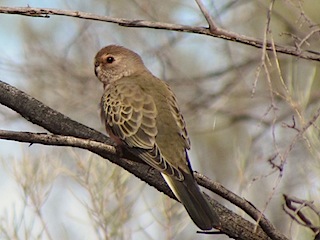 |
| Bourke's parrot |
21 June 2012
Up early, I had not ventured far when out of the mulga a large male bustard broke cover. Another Pilbara-first for me. There were thirty or so common bronzewings milling about so water wasn’t too far away. I located a small muddy pool where cattle had been loitering. While there were no birds drinking at the pool, they were everywhere else.
The habitat was scattered, scrappy mulga with scant understory but it presented some of my best birding in the Pilbara. There were pied and black honeyeaters, crimson chats and black-faced woodswallows feeding in the flowering corkwood Hakea lorea scattered through the mulga. Brown and singing honeyeaters and (my first Pilbara-seen) spiny-cheeked honeyeaters were everywhere. My first grey butcherbird called and later flew in. It had quite a distinct pale collar behind the neck and just a hint of breast band coming off the dark hood. (The birds in the Kimberley have much more of a breast band). Australian ringnecks, budgies, cockatiels and galahs were about, and later a few Bourke’s parrots flew in to drink. Chestnut-rumped and slaty-backed thornbills were in the mulga thickets. Three curiously marked but identical chestnut-rumped thornbills with a lot of rufous about the face and a partial rufous breast band had me scratching my head until it dawned on me they bore the pigment of the iron-rich Pilbara soil. White-winged and variegated fairywrens were also in the mulga. I pished up my first Pilbara-seen western gerygone Gerygone fusca mungi. It had the pale line along the wing of its counterpart around Alice Springs. The under parts of this subspecies, being almost pure white, are much paler than the widespread subspecies Gerygone fusca exsul found in the Deniliquin area. I heard the cuckoo-shrike like call that could only be a grey honeyeater. While I was pishing up slaty-backed thornbills the honeyeater came in and started feeding on the mulga leaves; whether on insects or secretions of insects, I couldn’t say. Several red-capped and hooded robins and rufous whistler were seen in the mulga as I made my way back to camp.
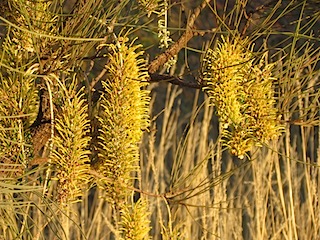 |
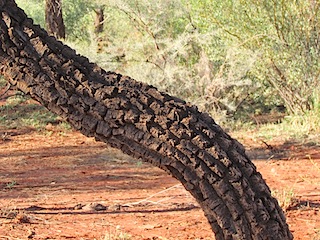 |
| Corkwood Hakea lorea |
As well as the feeding flocks, there were great mixed flocks of black-faced woodswallows, pied and black honeyeaters, budgies, trillers and crimson chats swirling about. A good camping spot indeed!
Packing up after lunch I drove southeast, crossing the Fortescue River once more. In a field of flowering corkwood, about ten kilometres southeast of the river, there were yet more huge mixed flocks of the species seen in the morning, with the addition of masked woodswallows, all feasting on the corkwood. Spotted harriers were also about.
I passed through magnificent gorges on my way to Karijini and inside the park stopped to take in the colours and patterns of the spectacular Hamersley Gorge.
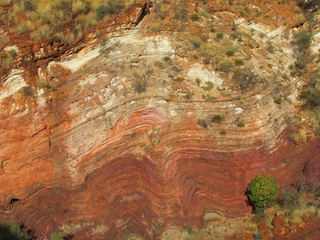 |
| Hamersley Gorge |
22 June 2012
Ron, a birding friend, had seen black-tailed treecreeper, rufous-crowned emu-wren and striated grasswren at Bee Gorge, just outside the Park, a couple of decades ago. I had tried to find my way in from the northern side as Ron had done but it appeared the track no longer existed. The ranger at Karijini had given me directions to get in from the southern side, so I gave it a go.
No problem getting in although the track was rough in places and low range 4WD employed. This track was high up over the gorge and there wasn’t much habitat suitable for any of the three sought-after species. The track seemed to continue on forever and became increasingly overgrown so after ten kilometres or so I turned back. This gorge was very deep and narrow in places and one of the side gorges had the most incredible rock particle formations.
Two male painted finches played about in the charcoal of a dead campfire. Other birds here included little buttonquail, spotted harrier, red-browed pardalote and black-chinned honeyeater. I suspect Ron saw the three species way down in the bottom of the gorge where it opened out on the north side. Too much time and effort were required to get down there so I retreated to Karrijini and checked out likely looking patches of spinifex for emu-wren and climbed a ridge for grasswrens but to no avail. Having had enough spinifex I headed back seventeen kilometres from the Hedland — Tom Price Road towards Hamersley Gorge to a spot I noticed on my way out. This spot had a creek lined with a large, grey, sickle-shaped leafed acacia, not unlike brigalow, and a few river redgums; and nearby, there were some big stands of mulga. In places the creek ran through spinifex ridges. Some old stone ruins were not far off the road. I camped in the mulga, just off the creek and far enough from the road to not hear the mining traffic. There were lots of birds here, the only new one being inland thornbill. Inland thornbills up here are very pale underneath and have a very light streaking on the throat.
The spinifex ridge beckoned the next morning and I soon had a mixed feeding party of birds (woodswallows/trillers/crimson chats/zebies/budgies). Little buttonquail flushed and a spotted harrier flew by. The Pilbara must be a significant wintering ground for both these species — in some years at least, with the buttonquail being a major prey item for the harrier.
23 June 2012
I headed back to the mulga and had my first decent sighting of crested bellbird. The rufous-breasted form of grey-crowned babbler wasalso about. While trying to photograph the thornbills and pishing to get their attention, another grey honeyeater came in. Further along the creek I pished up another three grey honeyeaters with the thornbills. One of the grey honeyeaters was eating something off the redgum leaves, so this species doesn't feed exclusively in acacia.
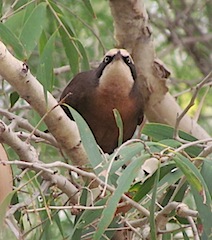 |
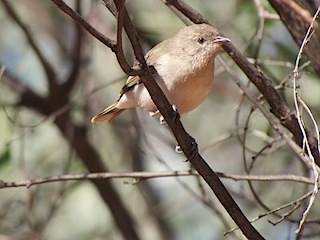 |
| Grey-crowned babbler |
Grey honeyeater |
Freshly minted dingo tracks were seen on the way back to camp.
The devil for punishment, I had one last look for grasswren in the gorge where the main road cuts through. My only observation worth mentioning was a western bowerbird feeding on figs, and a little woodswallow.
There was a dead dingo on the road in Millstream Chichester NP with a possessive wedgetail eagle devouring it. I dragged the dingo off the road and the wedgie resumed feeding. Both wedgies and dingoes seem scarce in the Pilbara, with only four wedgies seen in three weeks and only a few dingo tracks noted. They are heavily baited, which is a shame as they keep the fox and cat numbers down.
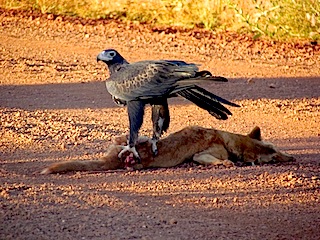
My time in this ruggedly beautiful part of Australia had come to an end. I highly recommend a visit to the Pilbara.